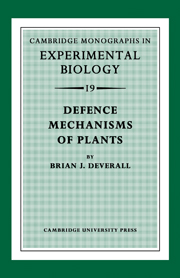Book contents
- Frontmatter
- Contents
- Preface
- 1 INTRODUCTION TO THE HOST–PARASITE INTERACTION
- 2 DISCRIMINATORY EVENTS BEFORE AND DURING PENETRATION INTO PLANTS
- 3 CYTOLOGICAL CHANGES IN HOST AND PARASITE AFTER INFECTION
- 4 CROSS-PROTECTION AND INDUCED RESISTANCE
- 5 PHYTOALEXINS AND THEIR INDUCED FORMATION AND BIOSYNTHESIS
- 6 ROLE OF PHYTOALEXINS IN DEFENCE MECHANISMS
- 7 MEDIATION OF HOST–PARASITE SPECIFICITY
- References
- Index
- Frontmatter
- Contents
- Preface
- 1 INTRODUCTION TO THE HOST–PARASITE INTERACTION
- 2 DISCRIMINATORY EVENTS BEFORE AND DURING PENETRATION INTO PLANTS
- 3 CYTOLOGICAL CHANGES IN HOST AND PARASITE AFTER INFECTION
- 4 CROSS-PROTECTION AND INDUCED RESISTANCE
- 5 PHYTOALEXINS AND THEIR INDUCED FORMATION AND BIOSYNTHESIS
- 6 ROLE OF PHYTOALEXINS IN DEFENCE MECHANISMS
- 7 MEDIATION OF HOST–PARASITE SPECIFICITY
- References
- Index
Summary
This book is concerned with the dynamic mechanisms involved in the defence of plant cells against attack by parasitic bacteria and fungi. Thus I scarcely discuss those plant features such as bark and cuticle which play an obvious role in defence, but which are essentially static contributors. Circumvent these barriers and the ability of apparently undifferentiated parenchyma to defend itself is revealed. Furthermore, this ability is dependent upon particular genes in plant and parasite which interact after infection. My interest is with the processes by which plant cells perceive the approach of an intruder and occasionally permit, but commonly discourage, its further progress. How do the genes of host and parasite communicate to determine the outcome of attempted parasitism? Is there a universal defence mechanism in all plants, and, if so, what is it? What contribution does the much studied process of phytoalexin formation make to the defence of plants?
Research on the physiology of host–parasite relationships has been prolific in recent years and a number of multi-author treatises are being published on different aspects of this work. Hopefully, this monograph will make a useful contribution by presenting a shorter and personal view of those parts of this research which bear directly upon the processes of resistance in plants. My envisaged readership comprises research workers in the subject, and University teachers and their advanced students in plant pathology, botany and plant biochemistry.
- Type
- Chapter
- Information
- Defence Mechanisms of Plants , pp. vii - viiiPublisher: Cambridge University PressPrint publication year: 1977



